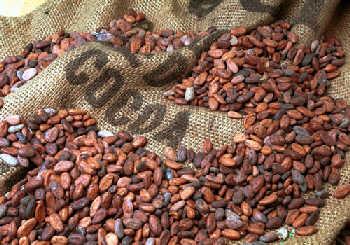Coffee is not guilty! Coffee is a kind of fruit!

Although there are a large number of cartoons and almost universally accepted legends that Eve ate a fruit from the Garden of Eden, the Bible does not say that Eve ate an apple. The record in Genesis is that she ate the fruit from the tree of good and evil. Why do people think Eve eats apples? One reason is that in Latin, the word "evil" is "malum", and the word "apple" is also "malum". In the fourth century AD, the word "malum" appeared in the phrase "tree of good and evil" in the Vulgate translation of Genesis. From then on, people began to associate the fruit Eve ate with apples. However, Eve did not eat apples, but ate the fruit on the tree of good and evil. So what kind of fruit did Eve eat? Some people think it is coffee fruit, because coffee fruit is healthier and more energizing than apples. In addition, the coffee fruit is bright red and looks like a small apple, so Eve probably ate it.
Fruit is an outstanding creation of nature. The health benefits of a diet rich in vegetables and fruits are indisputable: lower blood pressure; reduce the risk of heart disease, stroke and some cancers; reduce the risk of eye and digestive diseases; and have a mild effect on blood sugar and promote appetite. Eating a lot of fruit has a certain therapeutic effect, and it is said that many people cure chronic skin diseases by eating large amounts of fresh fruit and fresh fruit juice drinks regularly. Non-communicable diseases, especially cardiovascular disease, cancer, obesity and type 2 diabetes, are currently the main causes of a large number of deaths each year. The four epidemic factors of these diseases include poor eating habits, lack of physical activity, smoking and drinking, which are also important factors harmful to public health. Fruits and vegetables are an important part of a healthy diet. If you eat enough vegetables and fruits every day, you can effectively prevent major diseases, including cardiovascular disease and some cancers. According to the 2002 World Health report, about 31% of ischemic heart disease and 11% of strokes worldwide are caused by low intake of fruits and vegetables. If you eat enough vegetables and fruits, it is estimated that a total of 2.7 million lives can be saved each year. This once again confirms the well-known fact that you should eat more vegetables and fruits that have long-term health benefits, such as foods rich in dietary fiber, plant protein and protective trace elements. Recently, experts from the Food and Agriculture Organization of the United Nations and the World Health Organization jointly recommended that eating at least 400 grams of fruits and vegetables (excluding potatoes and other starchy plants) a day, after consultations on diet, nutrition and chronic disease prevention, can prevent chronic diseases such as heart disease, cancer, diabetes and obesity, and prevent and improve micronutrient deficiencies, especially in less developed countries. These recommendations further demonstrate the health effects of increased intake of vegetables and fruits on human health and contribute to concrete actions to promote increased intake of these foods.
Fruit also has calories. Compared with other fruit juices, coffee juice has almost zero calories. Generally speaking, the more water in the fruit, the lower the calories. Eating a lot of fruit is easy to lose weight because fruit is usually low in calories. The high water content of the fruit can help replenish the liquid balance, making you energetic and energetic. Fruit contains a lot of water and fiber to quickly create a sense of fullness, and eating a little fruit before each meal can prevent overeating.
There is growing evidence that some plant-based foods, such as cruciferous vegetables (kale, broccoli, Brussels sprouts, bean sprouts, cauliflower), carrots, green leafy vegetables, garlic and onions, can prevent some cancers and heart disease. Many medicinal plants are rich in medicinal active ingredients. A plant consists of several parts, including leaves, roots, fruits, flowers, bark, stems, seeds, etc., any part of which may contain active ingredients with medicinal properties.
Because these plants make up almost 95% of the human diet, and only 30 grains provide the calories and protein that most people in the world need, there is an urgent need to find a new plant that has both nutritional and medicinal value. For us, plants can not only supplement nutrition, they also have a positive effect on our spirit and psychology. A healthy diet should include plenty of fresh fruit juices, fresh fruits and vegetables.
The fruit of coffee is a fruit used to make the world's most popular beverage, which is more nutritious than some artificial drinks with caffeine, such as soda and energy drinks. Coffee belongs to Rubiaceae and is mainly divided into two categories: Arabica and Robusta. The fruit of the coffee shrub is bright red and oval, which contains coffee beans. Because it is easy to rot during processing, growers have to throw away the coffee fruit and only harvest coffee beans. Coffee beans are rich in a variety of bioactive ingredients, which play an important role in the human body and brain.
Through the "my Pyramid" structure map, the USDA strongly recommends that Americans eat vegetables and fruits. People who eat more vegetables and fruits can reduce the risk of many chronic diseases. In my Pyramid, any fruit or 100% fruit juice drink is included in the fruit group. Coffee should be the most important fruit in the food pyramid, because its fruit can make the healthiest drink.
Eating more vegetables and fruits can reduce the risk of stroke and cardiovascular disease. in addition, a diet rich in fruits and vegetables can also reduce the risk of type 2 diabetes and prevent some cancers, such as cancers of the mouth, stomach and ileum. Eating foods rich in fiber, such as vegetables and fruits, can reduce the risk of coronary heart disease. Eating potassium-rich vegetables and fruits can reduce the risk of kidney stones and prevent bone loss. Replacing some high-calorie foods with low-calorie vegetables can help reduce calorie intake. Most all-natural vegetables are low in fat and calories and do not contain cholesterol (seasonings may contain fat, calories and cholesterol). Vegetables are important sources of nutrients, including potassium, dietary fiber, folic acid, vitamin A, vitamin E and vitamin C. Potassium-rich vegetables, including sweet potatoes, sweet potatoes, white beans, tomatoes, green beets, soybeans, Lima beans, pumpkins, spinach, lentils, cashews and peas, can help keep blood pressure normal.
Dietary fiber from vegetables, as part of a healthy diet, can lower blood cholesterol levels and reduce the risk of heart disease. Fiber is important for maintaining normal gastrointestinal function. It can reduce constipation and diverticulosis. Foods that contain fiber, such as vegetables, produce a sense of fullness and have fewer calories. Folic acid in vegetables can help the body produce red blood cells. Women of childbearing age should eat enough folic acid in the first three months of pregnancy. In addition to getting folic acid from vegetables, folic acid can also be supplemented by fortified foods and supplements. Folic acid can reduce the risk of neural tube defects, spina bifida and headless infants during fetal development. Vitamin An in vegetables protects eye and skin health and prevents infection; vitamin E prevents peroxidation of essential fatty acids in cells; and vitamin C helps wound healing, protects teeth and gums, and assists the body in absorbing iron.
To replace the USDA's flawed pyramid, nutrition experts at the Harvard School of Public Health created the healthy eating pyramid based on the latest research on the relationship between diet and health. The healthy eating pyramid is similar to the USDA pyramid, but more forward-looking, redefining healthy eating through a large number of studies conducted over the past decade. This new pyramid makes up for the basic shortcomings of the USDA pyramid and provides reliable information to help people better choose their diet. The pyramid of a healthy diet is based on daily exercise and weight control, because these two related factors affect health to a large extent. Other elements of the healthy eating pyramid include: (1) whole grains (oatmeal, whole wheat bread, brown rice) as sources of carbohydrates; (2) vegetable oils (olive oil, salad oil, soy sauce, grain oil, sunflower oil, peanut oil and other vegetable oils), fatty fish (such as salmon); and (3) vegetables and fruits (which contain antioxidants that protect against heart disease and cancer). Fish, poultry and eggs (sources of protein); (4) nuts and legumes (sources of protein, fiber, vitamins and minerals); (5) dairy products (milk, fat-free or low-fat cheese) or calcium supplements (if you don't like dairy products); (6) red meat and cream (which contains a lot of saturated fat and should be used with caution, or red meat can be replaced with fish and chicken, butter can be replaced with olive oil) (7) White rice, white bread, potatoes, macaroni and sweets (should be used with caution); (8) multivitamins and moderate alcohol consumption (one cup a day for women and two cups a day for men can reduce the risk of heart disease).
The healthy eating pyramid is described in more detail in the 2001 book Diet and Health: a Guide to healthy eating at Harvard Medical School. Walter Willett, professor of epidemiology in the Department of Nutrition and Epidemiology, said: "the USDA diet pyramid has lost an opportunity to help Americans choose diet and long-term health, and it is clear that we need to completely rebuild the food pyramid." instead of adding or modifying it. Every American should do this. " In addition, there are food pyramids for Asia, Latin America, the Mediterranean and vegetarians, all of which provide a strong guide to healthy eating.
Important Notice :
前街咖啡 FrontStreet Coffee has moved to new addredd:
FrontStreet Coffee Address: 315,Donghua East Road,GuangZhou
Tel:020 38364473
- Prev

Coffee is not guilty because it is healthier than Coke.
In the United States, benzene content is the safe upper limit at 5ppt, while the World Health Organization limits it to 10ppt. Less than a year after Vault Zero operated in the United States, it was involved in today's lawsuit against Coca-Cola over benzene. Benzene is listed as a carcinogen by health authorities around the world, although the content in the drink does not pose a health hazard. Experts from the US Food and Drug Administration revealed for the first time
- Next

How much do you know about coffee's innocence? Not only contains caffeine.
In the past, people didn't pay much attention to the complex chemicals in coffee when they enjoyed it. People are mainly interested in the refreshing effect of coffee, rather than the health effects of drinking coffee regularly. But nowadays, food chemistry is becoming more and more important to our lives, because a series of serious diseases are related to our diet, and it is estimated that 3 percent of deaths in the United States are related to this. These.
Related
- Beginners will see the "Coffee pull flower" guide!
- What is the difference between ice blog purified milk and ordinary milk coffee?
- Why is the Philippines the largest producer of crops in Liberia?
- For coffee extraction, should the fine powder be retained?
- How does extracted espresso fill pressed powder? How much strength does it take to press the powder?
- How to make jasmine cold extract coffee? Is the jasmine + latte good?
- Will this little toy really make the coffee taste better? How does Lily Drip affect coffee extraction?
- Will the action of slapping the filter cup also affect coffee extraction?
- What's the difference between powder-to-water ratio and powder-to-liquid ratio?
- What is the Ethiopian local species? What does it have to do with Heirloom native species?

